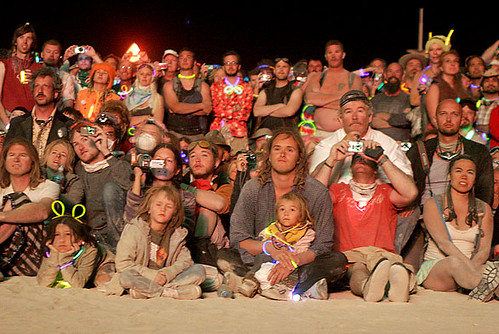 Visitors to center camp participate in guided meditative chanting. Group activities are a major theme at Burning Man. Photo: Spencer Weiner / Los Angeles Times
Visitors to center camp participate in guided meditative chanting. Group activities are a major theme at Burning Man. Photo: Spencer Weiner / Los Angeles TimesShould Burning Man be upgraded to a new religion?
Increasingly growing and ever so popular Burning Man has reached to level of a major gathering among the mostly white middle class liberal masses.
Started rather humbly as a bonfire ritual in 1986, San Francisco, the event since moved to Black Rock City, Nevada with a huge organizational logistics and ever upwardly folding budgets and participants. The tickets are now $295 per person in advance.
As many others, I have personally witnessed few of my boomer generation friends turning into "Burners" in recent years.
The organizers said as quoted in Wikipedia, "Trying to explain what Burning Man is to someone who has never been to the event is a bit like trying to explain what a particular color looks like to someone who is blind."
This is all good, however, we are not blinded and the statement does sound like a pre-emptive strike at the critics.
 Photo by; Spencer Weiner / Los Angeles Times
Photo by; Spencer Weiner / Los Angeles TimesWith the ticket holders' media champs WIRED Magazine and countless other happening blogs covering the event, it won't be easy to throw critical words without getting slammed by the homogenized, radical self-expressives and self-reliants, the proponents and the subjects of this new "western" religion.
Wouldn't be nice if the world was an effigy and the current problems in various continents were burned down with their collective energies before they have filled the fuel tanks and returned to their homes to download the digital pictures of their wildly creative burner community on heightened state of mind?
It is hi-time that somewhat pentagonally organized burners suit themselves with their own army and tanks to put out conflicts wherever they might be encountered!
The "carnaval art" must be able to fire...
 Burning Man from space, NASA
Burning Man from space, NASAI am not too shy to place this phenomena on the same shelve with evangelical TV prophesies and surface adopted shamanism, mixed together in a mind blowing cocktail, that must be consumed under the desert heat and further dodge the bigger questions of the real world with the fantastic and the "temporary wilderness" before returning to day jobs.
See you at the employees cafeteria folks... Oh wait, you might be a freelancer instead... Well, see you in the 'Internet,' then...
 Photo by Aaron Logan
Photo by Aaron LoganBy the way, there are over 3.5 million Burning Man results in the Google search but who can guarantee they all originate from Nevada desert? After all, men and women burn daily all over the world. Right?
It must be all about "shading" structures these days with the summer heat and all.
That is right, the carnival art must burn... Just like architecture must burn.
to hook this "ride" back to our blog's mother purpose.


